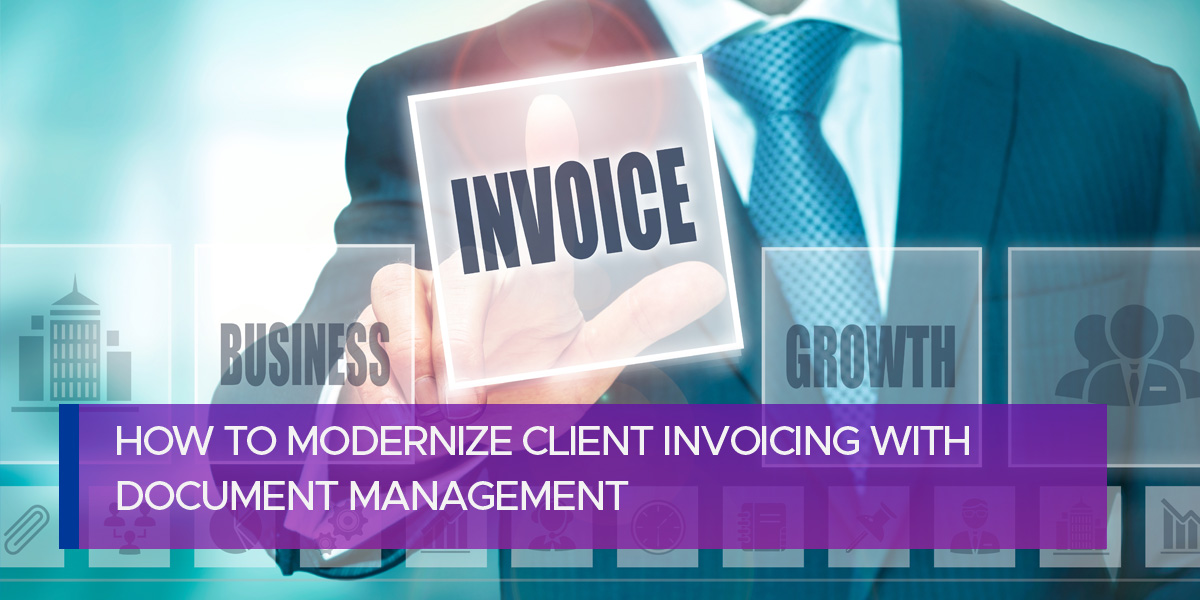
How to Modernize Client Invoicing with Document Management
Anyone who runs a business knows how frustrating invoicing clients can be without a reliable document management system in place. Between tracking down information, recording payments, and making sure that everything is correct, invoicing is practically a full time job on its own.
With document management, however, it doesn’t need to be. There is a whole suite of tools and strategies to help companies keep their invoices, records, and client information secure, and organized.
Are you tired of manually invoicing every client at the beginning of the month? Here’s how document management can modernize the process to give employees more time to deliver value to clients.
How Document Management Helps Modernize Invoicing
Document management is a strategy that helps manage how documents are created, accessed, transmitted, manipulated, and stored. With a solid management strategy in place, companies enjoy digitized, secure, streamlined document processes that are faster and more error-free. Document management can help modernize invoicing processes by:
1. Leveraging Automation to Streamline Processes
When it comes to documents, there are a lot of repetitive manual tasks that need to get done. However, as businesses increasingly handle greater and greater amounts of documents, doing these repetitive tasks by hand becomes rapidly unsustainable.
One of document management’s most significant advantages is the ability to automate numerous processes. For invoicing clients, a company can leverage automation to streamline the process through:
- Field population: Rather than having to look up contact information every single time, it’s now possible for a program to automatically fill out this information.
- Purchase history: Aggregate a client’s history and drop it into the invoice instead of hunting for purchases one by one.
- Invoice generation: Advanced document management tools can automate the entire invoice creation and delivery process. This is especially helpful for recurring monthly orders.
2. Improving Field Accuracy With Artificial Intelligence
Artificial intelligence has made inroads into document management and is finding more uses every day. In invoicing, artificial intelligence can be put to work in several surprising ways:
- Proofing: Optical character recognition combined with artificial intelligence, can help spot discrepancies or abnormalities in invoices before they’re sent.
- Data capture: Automate the capture and archival of essential pieces of information without errors or reducing the speed of the office workflow.
- Data mining: Gain insights into trends revealed in your clients’ order histories and revenue generation.
3. Enhancing Accessibility and Security Together
Document management leverages digital solutions to improve the accessibility and security of documents. For invoicing, this means more significant use of tools like cloud services. While all qualified employees will be able to access information for invoicing safely, it will also be significantly harder for unauthorized users to reach.
Likewise, document management assists with things like disaster planning by ensuring that reliable backups exist. Backing up documents, in particular, benefits from automation because it will happen regularly but without any additional effort on the part of employees.
4. Maintaining Organized Archives and Information Architecture
The average business is awash in data, and keeping all of that information organized can prove incredibly difficult. Automated data management keeps information organized and architecture flawless through things like:
- Data preparation: By standardizing file names and directory structures, the company’s information architecture takes on a uniform organization.
- Data mapping: Establish relationships between data models. This helps to lay the groundwork for data mining and analytics.
- Archival and retrieval processes: Spend less time filing and recalling information – automation can send the necessary information to and from the fingertips with ease.
5. Reducing the Amount of Time Invoicing Takes
Although it’s a critical business task, invoicing is ultimately time-consuming, rote, and not a very high-value activity. Efficiency matters, and employees already have plenty of tasks to complete to keep the business functioning smoothly. Document management makes it easier to move documents and data quicker through a business and out the door to the client’s hands. The result is less time spent on invoicing and more time spent with clients.
Edwards Business Systems Helps Companies Transform Their Document Processes
Document management is a valuable strategy for companies in the 21st century. Although the world has barreled towards a digital reality, documents remain as foundational to business as ever. Any office that is still doing invoicing by hand has an opportunity to optimize this process. With document management, companies can enjoy fast, automated, error-free invoicing that saves time and money.
EBS is thrilled to help companies achieve operational efficiency with the right tools and strategies. Contact us today to discuss your office’s document challenges.
